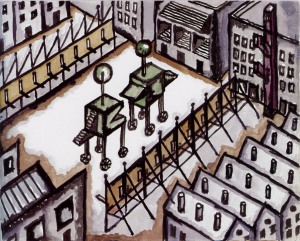I’m a yogi (I know, horrific image: me in shorts standing on my head). Without yoga I’d be a physical wreck. But entering into the world of yoga, one enters into an interesting philosophical construct as well. In the west, especially in Judaism and Christianity, we have the proscriptions of the Ten Commandments; in other words “thou shalt not.” The Yoga Sutras have a similar ten commandments, but five are proscriptions, and the other five are observances. Thus there is a balance between avoiding and seeking. In yoga, there are five afflictions or diseases: ignorance, egoism, attachment, aversion, and fear. Fear refers primarily to the fear of death, but this can also be viewed as fear of failure.
I bring this up because my students appear to be afraid to draw. I have experienced this fear myself. Even though very little is at stake, a blank sheet of paper can still be quite intimidating. But it is critical to overcome a fear and make things. Recall that the paper is not blank; it is already loaded with the ideas of the project. The paper is loaded with your own personal history. The paper is merely a vehicle. Recall that a drawing is not an end, but a part of a continuum. Sometimes you get it right, sometimes you make an awful mess. Sometimes it is from the messes that we learn the most. There is a fear that the hand is inadequate, that ugly drawings are going to be made. The drawing is not so much about the hand as it is about the mind. The drawing is merely a means for expressing ideas. The lines drawn are a notation. Once the idea forms, the drawing can start to take over. Apply experience to deepen the drawing. A drawing can almost always be saved, but it takes effort of the mind. A bad drawing is usually about a lack of depth of thinking, rather than a poor hand.
As a parting image, I include this drawing by John Hejduk. Hejduk had an awful hand. I get the sense that he held his pen like a 4 year old in his fist, point down. He certainly doesn’t have the elegance of Lebbeus Woods, or, referencing the current exhibit at MoMA, Henri Labrouste. But Hejduk’s work is not about the finesse of the drawing, but about the ideas they contain. To that end, his drawings are phenomenally successful – he has created an entire world.

